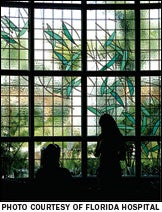Art programs aid recovery, improve satisfaction
 |
| A stained glass feature at Florida Hospital, Orlando |
A growing body of evidence suggests that arts-based programs in health care can go a long way toward saving money and improving patient satisfaction.
"There are research studies that show a correlation between the kind of art that people look at, or music they listen to, or interactive art programs … and their reduced anxiety levels, reduced stress, and their perceptions about how they feel about their overall health care experience," Blair Sadler, senior fellow at the Institute for Healthcare Improvement and author of Transforming the Healthcare Experience Through the Arts, told Health Facilities Management's sister publication Hospitals & Health Networks.
Health care arts programs incorporate visual and performing arts, music, photography, dance and drama into the healing environment. Slightly less than 50 percent of U.S. organizations currently have an art program, the most common being visual art in patient rooms and hallways.
A 2006 study published in the Journal of Pain and Symptom Management found that individuals with cancer who participated in a one-hour art therapy session experienced a reduction in many common symptoms.
Art programs can also impact a hospital's bottom line. A recent study conducted by American Art Resources Inc., Houston, looked at the effects of visual art on stress and aggression in psychiatric patients at a small state hospital. CEO and Creative Director Kathy Hathorn says that on the days artwork was on display, demands for PRN medications went down.




